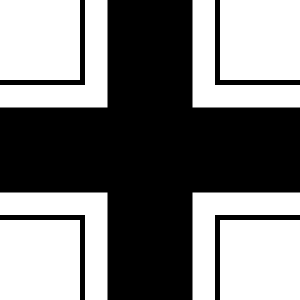Wehrmacht facts for kids

The Wehrmacht was the name for the armed forces of Nazi Germany from 1935 to 1945. It was made up of three main parts:
- The Heer (the army)
- The Kriegsmarine (the navy)
- The Luftwaffe (the air force)
The Waffen-SS was a separate armed group. It started small but grew very large during World War II. Even though it was not part of the Wehrmacht, it followed the Wehrmacht's top commanders.
Contents
What the Name Means
Before the Nazi Party came to power, the word Wehrmacht was used to describe the armed forces of any country. For example, people might have said Britische Wehrmacht for the British armed forces.
In 1935, the German armed forces, which were then called the Reichswehr, were officially renamed Wehrmacht. After World War II, the Wehrmacht was ended.
Today, when people say Wehrmacht, they are talking about Germany's armed forces during the time of Nazi Germany and World War II. It is important to remember that the Wehrmacht was not just the army. It included the army, navy, and air force.
History of the German Armed Forces
World War I ended on November 11, 1918, with a ceasefire. After the war, in 1919, Germany created a temporary army.
The Treaty of Versailles was signed in June 1919. This treaty placed strict limits on Germany's military. The army was allowed to have only 100,000 men, and the navy 15,000. Germany was not allowed to have tanks, heavy artillery, or an air force. A new military, called the Reichswehr, was set up in 1921.
Germany soon found ways around these rules. It secretly worked with the Soviet Union. Germany helped the Soviet Union with factories. In return, German tank and air force experts could train in the Soviet Union. German pilots trained at a place called Lipetsk. Tank training happened near Kazan. Poison gas was even developed for the German army near Saratov.
After President Paul von Hindenburg died in 1934, Adolf Hitler took over as the leader. He became the commander-in-chief of the armed forces. All soldiers and officers had to promise loyalty to Hitler.
By 1935, Germany was openly breaking the rules of the Versailles Treaty. On March 16, 1935, Germany brought back conscription. This meant young men had to join the military. The size of the army stayed at 100,000 men. But a new group of conscripts, also 100,000 strong, would be trained each year.
The law about conscription made the name Wehrmacht official. The Wehrmacht was officially announced on October 15, 1935. Its symbol was a simpler version of the Iron Cross, called the Balkenkreuz. This symbol had been used on planes and tanks late in World War I.
The War Years
The Army
When World War II began, most of the Wehrmacht's army units were not motorized. About 90% of the infantry (foot soldiers) walked everywhere. Artillery was mostly pulled by horses.
However, the motorized units got a lot of attention. They were seen as the reason for Germany's quick victories. These included the invasions of Poland (1939), Norway (1940), Denmark, Belgium, France, Netherlands (1940), Yugoslavia (1941), and early campaigns in the Soviet Union (1941).
When the United States joined the war in December 1941, the Wehrmacht faced two big industrial powers. At this time, Hitler took direct control of the Wehrmacht's high command. Many historians believe his poor decisions led to major defeats. This included big losses in early 1943 at Stalingrad and in North Africa.
The Air Force
The German Air Force, called the Luftwaffe, was led by Hermann Göring. It sent many ground units to fight in Russia and on the Normandy front.
In 1940, Fallschirmjäger (paratroopers) took over the Belgian Fort Eben-Emael. They also took part in the invasion of Norway. However, they lost many soldiers in the Battle of Crete. After this, large-scale paratrooper drops were mostly stopped.
Even so, paratrooper units still fought as regular infantry. The 1st Fallschirmjäger Division fought bravely in the Battle of Monte Cassino.
The German Navy, the Kriegsmarine, was very important in World War II. Controlling the shipping routes in the Atlantic Ocean was key for Germany, Britain, and later the Soviet Union.
In the Battle of the Atlantic, Germany's U-boat (submarine) fleet was at first very successful. But the Allies developed new technologies like sonar and radar. They also broke the German Enigma code. This helped them defeat the U-boats.
Germany had few large warships. This was because international treaties before 1935 limited their construction. The "pocket battleships" like Admiral Graf Spee and Admiral Scheer were important for attacking merchant ships only in the first year of the war.
Germany did not have any working aircraft carriers. Leaders lost interest in the Graf Zeppelin, which was launched in 1938. After the battleship Bismarck was sunk in 1941, the remaining large warships were ordered back to German ports. This was because Allied air power made it too dangerous for them to stay in French harbors.
The Waffen-SS
The Waffen-SS was not officially part of the Wehrmacht. But during World War II, they were under the Wehrmacht's top commanders. They were seen as elite troops and suffered very heavy losses.
Other pages
Images for kids
-
A tank destroyer battalion, part of the 21st Panzer Division of the Afrika Korps.
-
German paratroopers landing on Crete.
-
Karl Dönitz inspecting the Saint-Nazaire submarine base in France, June 1941.
-
German troops in the Soviet Union, October 1941.
-
German war cemetery in Estonia.
See also
 In Spanish: Wehrmacht para niños
In Spanish: Wehrmacht para niños











